table of contents
Introduction
The Desert Rose (Adenium obesum), a charming and exotic plant, stands out as a jewel in the gardening world. With its vibrant flowers and unique shapes, it has become a popular choice among ornamental plant lovers. In this section, we’ll explore the fascinating journey of caring for the Desert Rose, revealing its distinctive beauty and explaining why it has become one of the most coveted plants for adorning indoor and outdoor environments. Get ready to dive into the captivating universe of this unique species.
1. Getting to know the Desert Rose
The Desert Rose (Adenium obesum) is a fascinating plant that has its roots in the arid regions of Africa and the Arabian Peninsula. Its unique characteristics make it a popular choice among gardening enthusiasts. Let’s explore more about this exotic beauty.
Origin and characteristics
The Desert Rose is native to arid environments, which makes it adapted to conditions with little water. Its succulent structure and swollen caudex are remarkable adaptations for dealing with dry climates. The leaves can vary from green to grayish, contributing to its resistance.
Available Varieties and Colors
One of the attractions of the Desert Rose is the diversity of varieties and colors available. From vibrant shades of pink, red and purple to more subtle, multi-colored variations, there is a wide range to choose from. This diversity allows plant lovers to customize their gardens according to their color and style preferences. Explore the world of Desert Rose varieties and discover the beauty that captivates you the most.
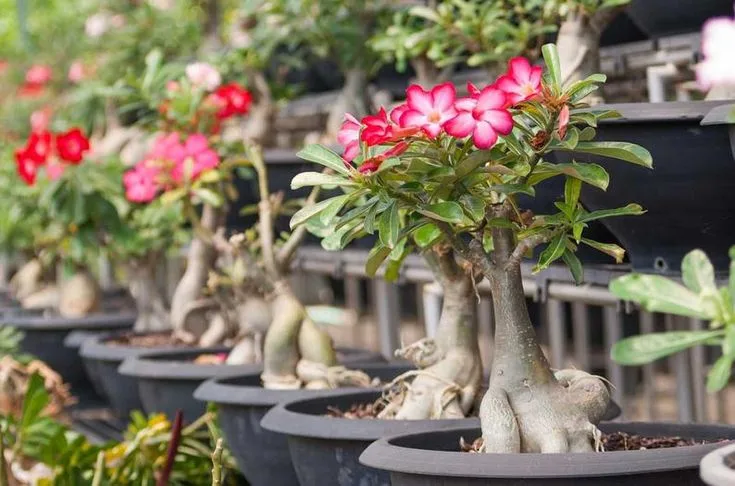
2. Choosing the right Desert Rose
When selecting your Desert Rose (Adenium obesum), it’s crucial to ensure that you get a healthy plant right from the start. Here are some tips to guide you through the buying process:
Tips for Selection at the Time of Purchase
- Firm Roots and Healthy Caudex: Make sure that the roots are firm in the substrate and that the caudex (swollen trunk) is robust, indicating a well-developed plant.
- Leaves without spots or deformities: Choose a Desert Rose with healthy leaves, without spots, deformations or signs of pests.
- Active Shoots: Opt for plants with active shoots, indicating vitality and continued growth.
Varieties Adaptable to Your Environment
Consider the specific conditions of your environment when choosing a variety of Desert Rose. Some considerations include:
- Light: Select varieties that suit the amount of light available in your home or garden.
- Climate: Choose varieties that thrive in the prevailing climatic conditions in your region.
- Available space: Consider the size the plant can reach and choose according to the space available.
By following these tips, you will be ensuring not only a visually appealing Desert Rose at the time of purchase, but also a plant that will thrive in its specific environment.
3. The right environment and lighting
Ensuring the right environment and lighting is essential for the healthy flowering of the Desert Rose (Adenium obesum). Here are crucial guidelines for providing the ideal environment, both indoors and outdoors:
Ideal Amount of Sunlight
- Direct sunlight:
- The Desert Rose thrives in places that receive direct, intense sunlight. Make sure the plant has access to at least 6 hours of sun a day for robust growth and lush flowering.
- Outdoor environments:
- In gardens or on balconies, position the plant in areas that receive as much direct sunlight as possible, especially during the morning and afternoon hours.
- Indoors:
- For indoor environments, place the Desert Rose near sunny windows. If necessary, use artificial grow lights to complement the natural lighting.
Suggestions for indoor and outdoor environments
- Outdoor environments:
- If grown in pots, choose pots with drainage holes to prevent excessive water accumulation.
- Make sure the soil has good drainage to prevent root problems.
- Indoor environments:
- Keep the Desert Rose near windows that receive abundant sunshine.
- Avoid cold drafts, especially during the colder months.
By following these guidelines, you’ll be providing your Desert Rose with the ideal conditions for healthy development, regardless of whether you’re growing it indoors or outdoors.
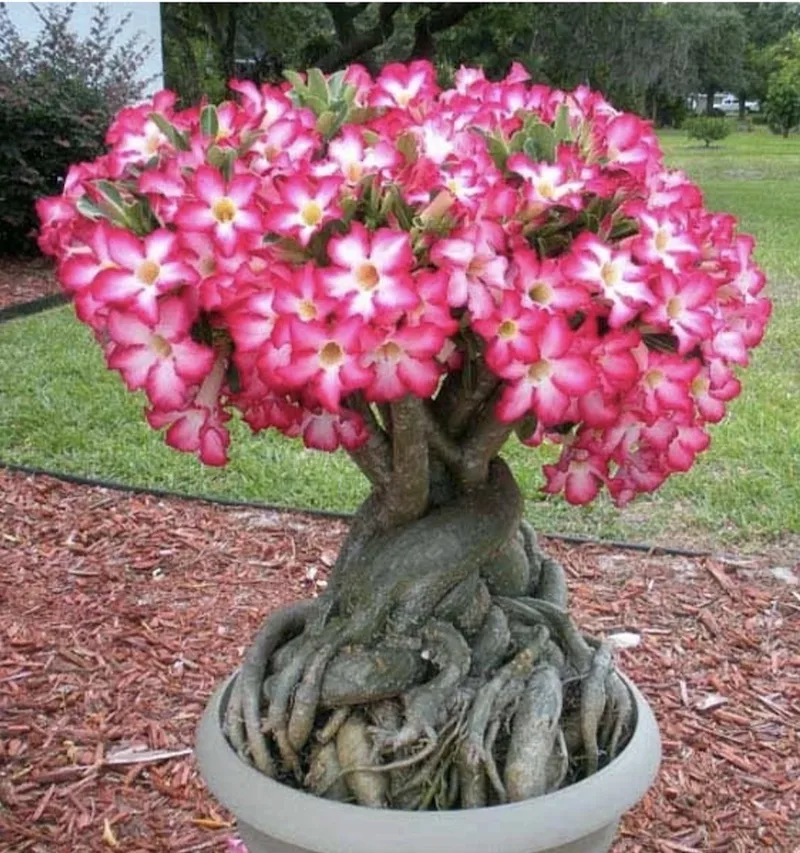
4. Efficient watering and drainage
Proper watering and drainage play a key role in the effective care of the Desert Rose (Adenium obesum). Here is a comprehensive guide to ensure your plant receives the right amount of water, while avoiding drainage-related root problems:
Watering Guide
- Water Requirement:
- The Desert Rose is a succulent plant, adapted to arid climates. Avoid overwatering by allowing the soil to dry out completely between waterings.
- Humidity test:
- Before watering, check the soil’s moisture by inserting a finger to a depth of about 2 centimeters. Only water when the top layer is dry.
- Moderate watering:
- When watering, do so moderately, allowing the water to reach the deep roots. Avoid leaving the plant in stagnant water.
Importance of drainage
- Soil choice:
- Use a well-drained substrate, adding perlite or sand to the soil to improve drainage.
- Pots with holes:
- When growing in pots, make sure they have adequate drainage holes to prevent water accumulation.
- Pot inclination:
- Position the pot slightly inclined to allow the water to drain efficiently.
By following these guidelines, you will be meeting the specific water needs of the Desert Rose, promoting an ideal balance between proper watering and preventing drainage problems.
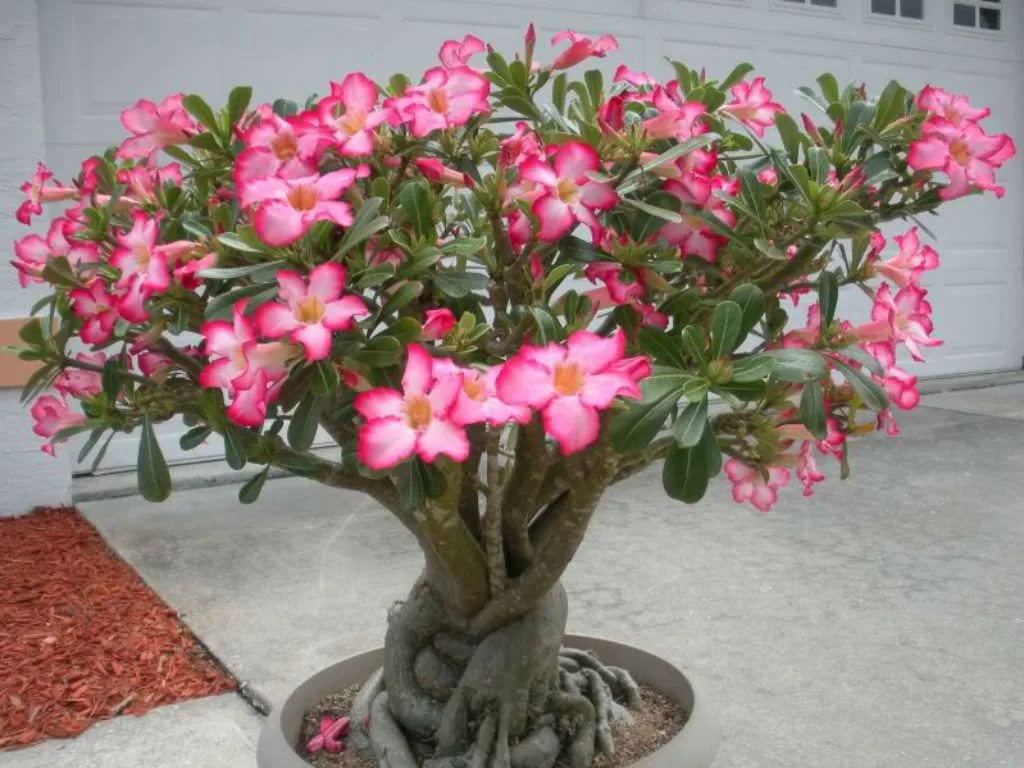
5. Ideal substrate and pots
Selecting the right substrate and choosing the appropriate pot are crucial steps in ensuring the healthy development of the Desert Rose (Adenium obesum). Let’s explore specific recommendations for optimizing the growing environment:
Choice of Substrate
- Well-drained soil:
- Opt for a specific substrate for cacti and succulents, ensuring good drainage. Add perlite, sand or pumice to improve aeration.
- Rich in nutrients:
- Choose a substrate enriched with nutrients, as the Desert Rose appreciates slightly fertile soil.
- PH Balanced:
- Check the pH of the substrate, aiming for a range between 6.0 and 7.5 to promote proper nutrient absorption.
Guidelines on the Size and Type of Pot
- Suitable size:
- Initially, plant in a moderate-sized pot to avoid excessive water accumulation. Increase the size of the pot as the plant grows.
- Pots with drainage holes:
- Make sure the pot has adequate drainage holes to prevent water from stagnating.
- Vase material:
- Clay or ceramic pots are recommended, as they help control humidity and provide a more stable environment for the roots.
By following these recommendations, you will be providing your Desert Rose with the ideal conditions in terms of a nutritious substrate and a well-designed pot, promoting an environment conducive to its healthy flowering.
6. Balanced fertilization
Maintaining balanced fertilization is essential to promote the vigorous development of the Desert Rose (Adenium obesum). We will explore the importance of fertilization and provide practical suggestions for fertilizers and frequency of application:
Importance of Fertilizing
- Stimulating Growth:
- Fertilizing provides the essential nutrients that boost the plant’s healthy growth, stimulating the production of new leaves, flowers and caudex.
- Exuberant flowering:
- Proper fertilizing contributes to more exuberant flowering, resulting in vibrant, long-lasting blooms.
- Disease resistance:
- A balanced supply of nutrients strengthens the Desert Rose’s resistance to disease and environmental stresses.
Fertilizer Suggestions and Frequency of Application
- Balanced Fertilizer for Succulents:
- Use a specific fertilizer for succulents, balanced with macronutrients such as nitrogen, phosphorus and potassium.
- Apply in spring and summer:
- During the active growing season (spring and summer), apply the fertilizer every two weeks.
- Reduction in the dormant season:
- Reduce the frequency of fertilization during the dormant season (autumn and winter) to allow the plant to rest.
- Slow Release Fertilizer:
- Consider using slow-release fertilizers for continuous nutrition over time.
By following these suggestions, you’ll be ensuring balanced fertilization, providing your Desert Rose with the nutrients it needs for healthy growth and a vibrant appearance.
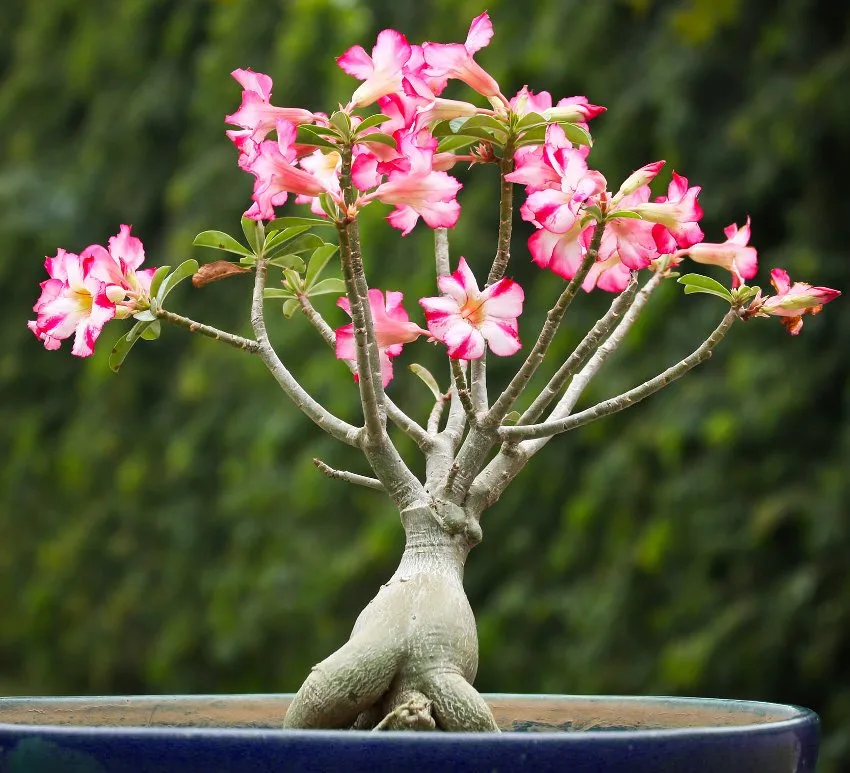
7. Pruning and stimulating flowering
Proper pruning plays a crucial role in stimulating the growth and lush flowering of the Desert Rose (Adenium obesum). Let’s explore essential instructions on how to prune correctly to promote healthy development:
Pruning Instructions to Stimulate Growth and Flowering
- Removing Unwanted Shoots:
- Prune unwanted shoots to direct the plant’s energy to the main branches and stimulate more robust growth.
- Pruning wilted flowers:
- Remove wilted flowers to encourage the development of new flower buds and extend the flowering period.
- Thinning Excessive Branches:
- Thin out excess branches to ensure an equitable distribution of energy and promote a more balanced structure.
- Caudex Selective Pruning:
- Carry out selective pruning on the caudex to maintain the desired shape of the plant and avoid disordered growth.
Ideal time to prune
- Prune in spring:
- Spring is the ideal time to carry out more intense pruning, as the plant enters its most active growth phase.
- Maintenance throughout the year:
- Carry out maintenance pruning throughout the year, such as removing damaged or disordered parts, to promote the plant’s continued health.
Remember to sterilize pruning tools to prevent the spread of disease. By following these instructions, you will be promoting healthy growth and stimulating lush flowering in your Desert Rose.
8. Pest and Disease Prevention
Keeping your Desert Rose (Adenium obesum) free from pests and diseases is crucial to ensuring its vitality and lasting beauty. Let’s explore the identification of the most common pests and offer preventative measures as well as solutions for frequent diseases:
Identifying the Most Common Pests
- Mites: Small insects that suck the sap from the leaves, causing yellowing and deformation.
- Mealybugs: Insects that feed on the sap, forming white or brown clusters on the leaves.
- Aphids: Small, soft-bodied insects that feed on the sap, causing leaf deformities.
Preventive Measures and Solutions for Frequent Diseases
- Pest prevention:
- Regular inspection of the leaves to detect early signs of infestation.
- Isolate new plants before incorporating them into the environment to prevent the spread of pests.
- Biological control:
- Introduction of natural predators, such as ladybugs, to control populations of mites and aphids.
- Neem oils and insecticidal soap:
- Apply neem oils or insecticidal soap to control pests. Repeat as necessary.
- Treatment for Fungal Diseases:
- Specific fungicides for succulents can be applied to treat problems such as powdery mildew and mildew.
- Manual Pest Removal:
- Remove visible pests manually to prevent a more serious infestation.
Remember to maintain a clean and well-ventilated environment, as healthy plants are more resistant to pests and diseases. With consistent preventative measures, you’ll be strengthening your Desert Rose’s resistance to possible problems.
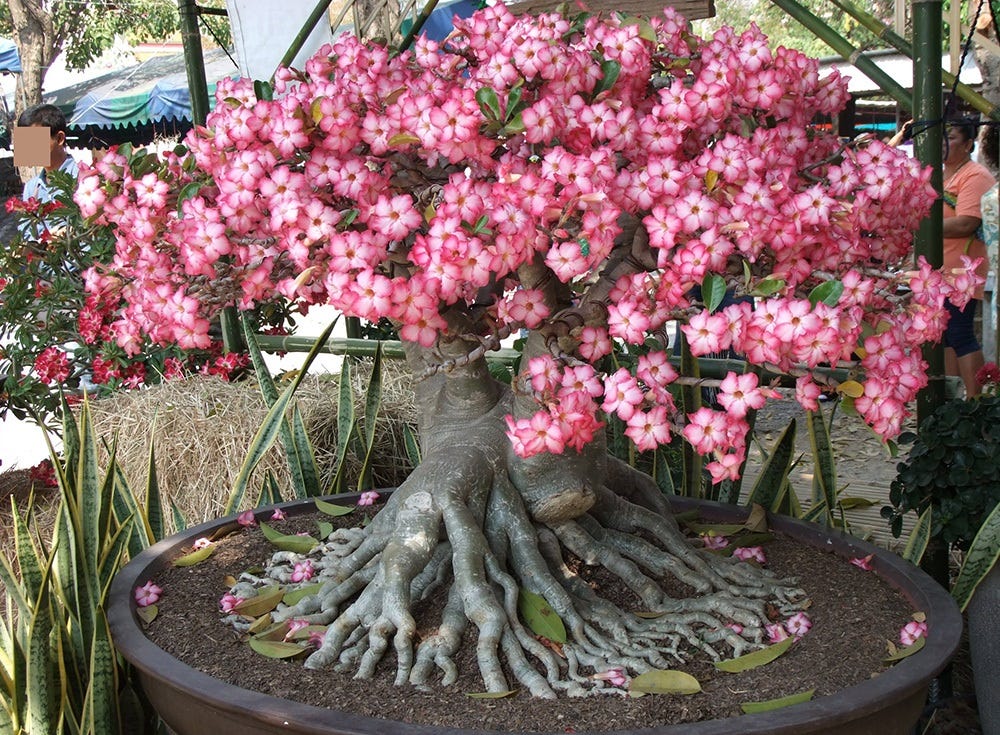
Conclusion
Throughout this guide, we have explored essential steps to ensure effective care and lush flowering of the Desert Rose (Adenium obesum). Let’s recap the fundamental guidelines that will help you successfully cultivate this enchanting plant:
Essential Steps for Caring for the Desert Rose:
- Knowledge of the Plant:
- Understanding the origin, characteristics and varieties of the Desert Rose.
- Careful selection:
- Tips for selecting a healthy plant and varieties that are adaptable to their environment.
- The right environment and lighting:
- Guidance on the ideal amount of sunlight for indoor and outdoor environments.
- Efficient watering and drainage:
- Guidance on watering, considering the plant’s water needs, and the importance of drainage.
- Substrate and Ideal Pots:
- Recommendations for choosing the substrate and guidance on the right size and type of pot.
- Balanced fertilization:
- The importance of fertilizing for vigorous growth, with suggestions for fertilizers and frequency of application.
- Pruning and stimulating flowering:
- Instructions on pruning to stimulate growth and flowering, indicating the ideal time to carry out pruning.
- Pest and Disease Prevention:
- Identification of the most common pests and preventative measures to keep the plant healthy.
Final Encouragement: Grow your Desert Rose with Confidence!
By following these steps, you are well on your way to growing a vibrant and healthy Desert Rose. Remember to adjust your care practices according to the specific conditions of your environment. Growing this unique plant will not only add beauty to your space, but will also provide a rewarding experience for any plant lover. Cultivate with care, watch it bloom and enjoy the lasting beauty of your Desert Rose. Happy gardening!
Frequently Asked Questions
Can I keep my desert rose indoors?
Yes, you can grow your desert rose indoors, as long as you provide it with the right amount of sunlight. Place it near a sunny window to ensure the necessary lighting. Make sure the indoor environment provides conditions similar to its natural habitat, including good ventilation and a moderate temperature.
How often should I water my desert rose?
The frequency of watering for the desert rose varies with the environmental conditions. In general, it is recommended to water when the soil is completely dry. Test for moisture by inserting a finger into the soil; if it feels dry, it’s time to water. Avoid overwatering, as the desert rose is a succulent adapted to drier environments, and a build-up of water can lead to root problems.
Where is the best place to keep a desert rose?
The best place for the desert rose is in areas that receive direct, intense sunlight. Outdoors, choose sunny areas, while indoors, place it near windows that receive abundant sunlight. Make sure to provide protection from cold drafts, especially during the colder months. The ideal location will provide the necessary light for the plant to flourish healthily.







